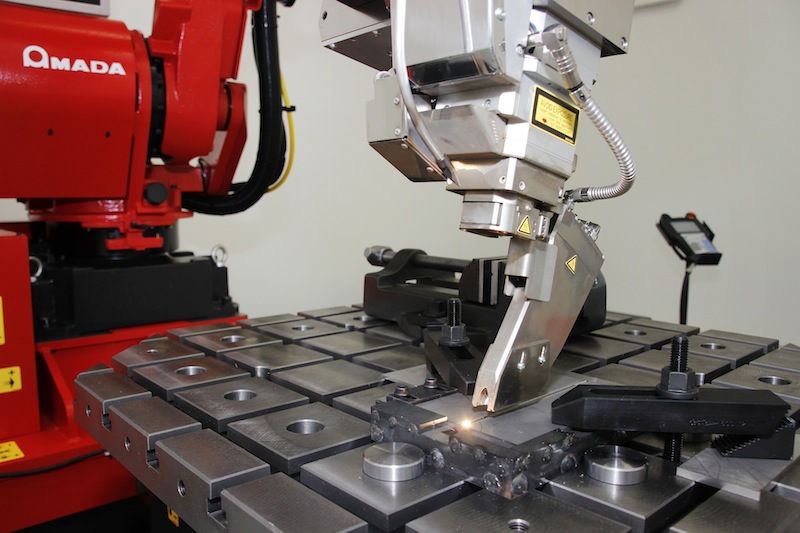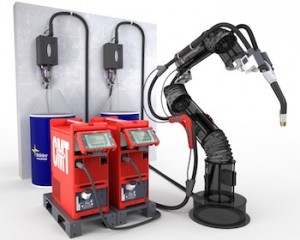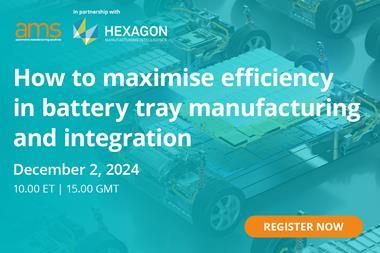An assessment of automotive joining trends reveals a healthy appetite for innovative new technologies
The productive, cost-effective, yet high-quality welding of automotive assemblies and parts has become the Holy Grail in what is one of the most competitive marketplaces in the world. For body-in-white (BIW) applications particularly, different joining technologies are developing at a rapid pace. According to The Welding Institute (TWI) in Cambridge, UK, the adoption of these technologies varies considerably from plant to plant, and model to model, as illustrated by a recent comparison of the millimetres joined on BIWs for the Porsche Cayenne, Audi A3 and VW Golf.
The study revealed that resistance spot welding remains the dominant technology, commanding between 45% and 53% of total millimetres joined. However, while adhesives represent 37% on the Cayenne and 25% on the A3, they account for only 7% on the Golf. Conversely, 45% of joins are completed by laser welding/soldering on the Golf, but this technology accounts for 15% on the A3 and just 4% on the Cayenne. MIG/MAG welding is only 1-3% across the three models. Tailored welded blanks (TWBs) are also present on the Cayenne.
Among all of these processes, robotics expert ABB says that the use of remote laser welding has increased considerably in recent years, a trend that is forecast to continue. “This segment is expected to be the fastest-growing in the future because laser welding is a versatile system capable of joining a variety of materials,” states Pedro Garrido, the company’s global sales manager, welding and cutting. “Laser welding also ensures deep weld penetration, helping to simplify part designs, and high speeds, while maintaining low distortion due to low heat input for minor changes in microstructure.”
Garrido asserts that the increasing integration of robots and new welding peripherals is of paramount importance, and so ABB has made recent advances towards the integration of its robot controller with laser equipment – developments which essentially comprise three key components. Firstly, the creation of a specific library for robot programming offers welding instruction with embedded robot motion, on-the-fly and stationary welding modes, process parameterisation through dedicated data types, and user routines for customisation and adaptability. Secondly, an enhanced robot-laser interface co-ordinates scan-head mirrors and robot motion with exchange of status and laser commands, as well as program selection. The final, but no less important element, is ease-of-use.

The second is RobotStudio for remote laser welding on-the-fly. This allows the importation of scanner-head programs. Here, the tool emulates the behaviour of the real scanner head and its interaction with the robot controller. It reproduces the programs according to the robot input commands, before outputting program status feedback to the robot as it would do in the real device. This assists the user in tuning and optimising the process.
Other welding processes gaining steam in the automotive industry, particularly at supply chain companies, are various forms of friction welding. Among the latest developments is the AX 5 from Thompson, a friction-welding machine for joining commercial-vehicle drive and trailer axles. As well as an improved flash removal collection system, the machine incorporates a new chuck design with simplified jaw fixings for accommodating larger diameter spindles. In addition, a newly developed base design has been introduced for smaller axles, while a new hydraulic system with enhanced pressure control aids final precision.
Available in either a single- or double-ended version, AX series machines are already used by major truck-axle manufacturers around the world, according to Thompson. The equipment includes a self-centring, adjustable bung for supporting drive axles and is supplied with weld cycle control software.
CMT: a hot new trend
Those with an eye on new industry developments will also have noted the growing momentum of cold metal transfer (CMT) processes. Fronius, for example, has introduced CMT Twin, a tandem welding process that allows users to exploit two CMT processes or combine a CMT process with a GMA pulsed-arc welding process in a single system.
Pitched specifically at the automotive sector and its supply chain, the machine comes with two digital power sources that work completely separately from one another, allowing the weld processes to be tailored individually to the differing requirements of each application, and permitting the selection of any wire feeder (within given physical limitations). This makes it possible to set widely diverging wire-feed speeds, as well as allowing flexibility in terms of which weld processes are deployed. It is said that users can precisely control the thermal input and deposition rate, enabling optimum welding speed and seam quality with virtually any welding position and combination of materials.

However, for welds requiring a large seam cross-section, there is a risk that excessive heat input may cause problems — as on fillet welds, where the seam will ‘sag’ if the weld pool becomes too liquid. These cases call for a process in which the thermal input is lower and can be adjusted accurately.
CMT Twin has been developed to combine the advantages of Time Twin and CMT in one system to aid the welding of light-gauge sheet at high speed, and for positional welding with high deposition rates (without exceeding the optimum thermal input).
So, what are the key benefits of the process? The use of CMT, in which the electrode is moved back and forward in a controlled manner during welding so as to manually assist droplet detachment, means it inputs considerably less heat than a conventional dip transfer arc. Furthermore, hardly any spattering occurs, and the process is considered stable since the arc length is unaffected by the surface of the workpiece or the welding speed.
High welding speeds can be achieved; in the case of a fillet weld at the lap joint of two 2mm steel sheets, as fast as 4m/min. To ensure a good weld right from the beginning, in CMT Twin the ‘trail’ electrode does not operate until the ‘lead’ electrode process has stabilised and the power source for the ‘trail’ electrode has received a start-up signal.
Leading with lasers
Of course, laser welding continues to be the area where most R&D hours are currently spent, giving rise to a host of alternative takes on this innovative process. Fibre laser welding, for instance, is rapidly usurping more conventional CO2 variants. In machines such as the recently introduced FLW 4kW laser welder from Amada, the laser beam has a wavelength that is about one-tenth that of a CO2 laser, helping to produce high-speed results even when processing reflective materials such as brass and copper, and combinations of dissimilar materials that are traditionally difficult to weld.
The chief innovation is the patented rotating lens; the laser beam is no longer aligned with a specific point along the target path but circles within a small area during welding. The rotating lens makes it possible to bridge larger and uneven gaps while producing a clean, even weld, states the company. The heat input into the material is also said to be optimised, which results in precisely defined weld edges with virtually no unnecessary deposits of material.
Retaining the laser theme, but this time for thin strip used predominantly in the supply chain, an interesting market entrant is the LHMA laser welder from Guild International, a machine that can create complete edge-to-edge welds without the need for start and stop tabs, on strip as thin as 0.076mm – which, until now, has not been available.
The machine deploys a fibre laser to deliver the necessary energy for welding via an optic cable connected to a focusing head. The focusing head concentrates the energy to a very fine spot, thus achieving weld results never before possible on thin steel, stainless steel, cooper, brass and aluminium. The system is designed for use on either start/stop lines or continuous lines, including stamping lines and other thin strip production lines. LHMA machine includes a camera and HMI touchscreen, allowing the operator to view the strip fit-up prior to welding. In just two minutes, the process of shearing, aligning, and welding the two coil ends is complete. Weld schedules can be stored for quick retrieval and the parameters are easily set using the HMI.
Demands for greater productivity, efficiency and quality present notable challenges to the welding industry. As materials become ever more complex in their chemical composition to provide ever-better functional properties, a more thorough and accurate comprehension of how such materials can be welded will be essential. For now, resistance spot welding remains the dominant force in automotive welding operations. However, laser welding has made huge inroads, while alternative processes such as friction welding, CMT and TWBs offer huge potential.

According to ArcelorMittal, among the most notable emerging TWB trends is hot stamping, which is enjoying significant growth; by heating the steel before stamping and quenching it quickly during stamping, this method offers excellent component formability and high mechanical properties. ArcelorMittal says the current standard is steel with strength of 1500MPa, although the company is developing a 2000MPa solution.
"The combination of TWB and hot stamping offers remarkable oppportunities to further reduce weight while improving the crash performance of vehicles,” says Vincent Daenen, head of communications for the automotive business at ArcelorMittal Europe. “Our recently unveiled hot-stamped, one-piece door ring, first applied on the Acura MDX manufactured in the US, is proof of its potential. High-strength, high-formability steel grades for cold stamping are also being developed in order to proffer a wide portfolio of solutions.”
ArcelorMittal’s Tailored Blanks division produces welded blanks in 20 plants throughout the world. The company has recently developed a process called ablation, which is said to ensure a strong weld of aluminium/silicon-coated sheets, by far the preferred coating for steels used in hot stamping operations. This process is now being rolled out to several plants around the world to support the fast-growing demand of TWB for hot stamping.
Rounding up its current investments in this area, ArcelorMittal is currently looking to add extra door-ring capacity for 2016 in North America. Significant investments are also taking place in Lorraine, France, to enhance the plant's capabilities so that it has the best equipment to process Usibor, ArcelorMittal’s product for hot stamping.
“After having opened a new facility in Slovakia two years ago to better serve our customers’ production plants in Eastern Europe, our Tailored Blanks Division is further expanding this factory to accommodate growing demand,” says Daenen. “Tailored Blanks has also expanded its operations in the UK, to follow the growing needs of OEMs based there. Ultimately, we see TWB as an important component of ongoing developments in advanced steel solutions.”


































